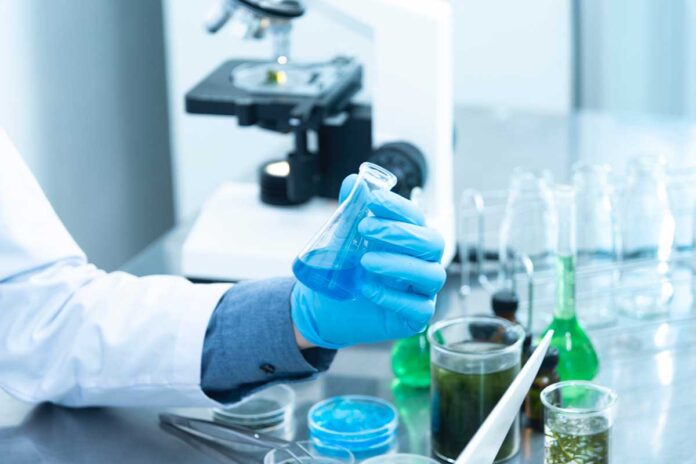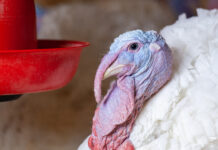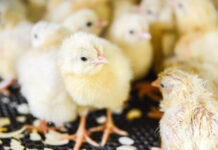
Identifying alternative replacements for soybean meal in a high quality and reasonable price is of importance in poultry production and physiological parameters. Spirulina platensis Algae (SPA) is a natural feed additive with 40-45% crude protein (CP), 2.44% calcium, and 6.27% phosphorus. The effects of dietary supplementation of SPA on productive performance, serum lipid profile, calcium (CA) and inorganic phosphorus (IP) content in serum and tibia bone was investigated.
Introduction
The continuous development of the poultry industry and the use of antibiotics for the prevention of diseases in order to raise production efficiency for production of meat and eggs as well as use of antibiotics in feed resulted in the development of drug-resistant bacteria, antibiotic residues body weight in broiler chickens and decreased numbers of intestinal microflora.
The current trend in poultry feed is to use natural ingredients as an alternative to antibiotics, artificial colors, and other chemicals in order to maintain human health and safety. Spirulina (blue and green algae) is one of the high quality natural feed additives and nutritional efficiency of animals and poultry feed. Spirulina platensis are widely diffused and is widely found in Africa, Asia and South America. Blue and green algae (Spirulina platensis) have been used for hundreds of years as an important food source for humans and animals because of the high nutritional value and high content of carotenoids. Spirulina is rich in protein content ranging from 55 to 65% as well as containing most essential amino acids. Spirulina contains a high content of thiamine, riboflavin, pyridoxine, vitamin B12, vitamin C, carotenoids, calcium, iron and antioxidants.
However, there are some biological sources of calcium that can be used in a broiler chicken diet. Spirulina platensis Algae(SPA) is one of these biological sources of calcium that is found in the Red Sea, on a large scale. In addition, Spirulina has been shown to improve immune system, reproduction and growth traits. Spirulina supplements in chicken feed were found to be defense systems improver by increasing the ability to kill microbes, to synthesize antigens and increase T cell activity.
The aim of this work is to study the effect of Spirulina platensis Algae (SPA) supplementation in broiler chicken diets on productive performance, lipid profile and metabolism of calcium-phosphorus.
Materials and methods
The current study was conducted at the poultry research center, Faculty of Agriculture, Alexandria University, over the period from March to May 2015.
Preparation of samples
Spirulina platensis Algae(SPA) used in this experiment was purchased from commercial company in Borg El-Arab City. The company harvested Spirulina from red sea, oven dried at 60 °C for 24 h and ground to powder by a hammer mill, finally stored in polyethylene bags until used in formulations.
Chemical Analysis
Duplicate samples of SPA were analyzed for chemical composition in our birds feed laboratory Table 1. In brief, the samples were dried out of the oven and the chemical components of crude protein samples, moisture, crude fat, crude fiber, soluble carbohydrate; total ash, calcium and total phosphorous were analyzed according to the methodologies described by AOAC.

Birds and their management
A total number of 480 Cobb broiler chickens were acquired from a local commercial breeder. A program was used to vaccinate chickens against Newcastle and infectious bronchitis (IB) diseases when hatched and vaccinated against H5N2 at the age of 9 days. Chicks are raised from day to 7 days together and under the same conditions. The ambient temperature was maintained at 32 °C for the first three days and then gradually decreased to 21 °C in 21 days of age. Starting from day 8 of age, chicks were divided into 3 random experimental groups of 4 replicates each with 40 chicks and were housed in a clean floor house. Table 2 contains the nutrient composition of feed mixtures and experimental treatments. One of the 3 experimental groups was fed this diet as such to serve as control while; the remaining two groups were fed diets with SPA 30 and 60 kg/ Ton diet (3 and 6%) till 42 days of age. SPA was included into diet by substituting the soybean meal content all mostly. The chicks control group and experimental groups with 3 and 6% SPA were reared under similar management conditions with ad libitum supply of feed and water.

Data collection
Growth Performance Traits
All birds were individually weighed weekly from 7 and 42 days (Slaughter age). The weekly weight gain of broilers and feed consumption were taken and calculated at the end of each week. Feed conversion ratio (FCR) were calculated subsequently based on the weekly body weight gain and feed consumption. Mortality was recorded daily and morbidity as mortality rate (MR) per weekly basis and calculated at the end of experimental period (42 days of age).
Blood collection and biochemical analyses
At the end of the experimental period, 16 broilers from each treatment were randomly taken for slaughter. 3 ml of blood samples were collected before slaughtering birds from a vein in the wing for biochemical analysis. Serum total lipids, triglyceride and cholesterol were determined by using special kits by means of spectrophotometer according to recommendation of (Frings and Dunn, 1970, Allain et al., 1974 and Fossati and Prencipe, 1982), respectively. Low density lipoprotein (LDL) and high density lipoprotein (HDL) were determined using colorimetric method by commercial kits obtained from Reactivos GPL, Barcelona, Spain. Serum calcium (Ca) and inorganic phosphorus (IP) concentrations were determined by colorimetric method, using double beam spectrophotometer with commercial kits transmitted from sentinel CH. Milano, Italy.
Tibia traits
The left tibia of each slaughtered bird was taken to measure the tibia characteristics and minerals (Ca and IP) concentrations. Briefly, tibia was de-fleshed, and cartilaginous caps were removed immediately after collection. To determine the minerals concentrations, all frozen tibias were kept in plastic bags at a temperature of -20 °C to maintain wetness until the analysis was performed. Then dissolved by leaving it in plastic bags at room temperature for one hour and then dried in the oven at 105 °C for 12 h. The samples were then grinded in a mill, weighed and placed in a muffle furnace overnight at 550 °C for 3 h. The ash was used to quantify calcium and phosphorous amount in the tibia with atomic absorption spectrophotometer using appropriate lamp (AOAC, 2005 method).
Economical efficiency
Economical efficiency of production was calculated from the input-output analysis of the money, based on the differences in both growth rate and feeding costs. The value of the economical efficiency was calculated as the net revenue per unit of total feed costs. The prices of experimental diets and live body weight were calculated according to the prices of the local Egyptian market at the time of experiment (2015) according to the formula of Riad et al., 2010.
Net Revenue = Total Revenue – Total feed cost
Economical efficiency = Net Revenue / Total feed cost x 100
Relative economical efficiency (%) affecting the control treatment = 100%
Statistical analysis
The experiment was set in a completely randomized design. Analysis of variance using the general procedure of the liner model for analyzed data experimental (Proc GLM; SAS Institute, 1999). The Duncan test was used to calculate differences between methods.
Results and discussion
Growth performance
Table 3 shows that broilers BW and weekly BWG of 6% SPA recorded higher (P≤0.05) final BW and BWG at 42 days of age, compared to 3% and control groups by (5.45 and 6.19%) and (5.89 and 6.76 %), respectively.
It is worthy to note that the improvement in final BW and BWG which occurred in broiler chickens administrated SPA may be due to the biological functions of the main components of the residual essential amino acids in SPA.
SPA supplementation to broiler diet had no effect on feed consumption at the end of experimental period, but improved feed conversion ratio (FCR). Results on Table 3 showed that average values of FCR of broiler chickens in 3 and 6% SPA improved significantly by 4.76 and 3.70% comparing with control group at 42 days of age, respectively. The improvement of FCR as a result of SPA supplementation to broiler diet could be attributed to the increase in BW accompanied with no effect on FC.

Mortality rate (MR) was not significantly decreased in all groups. Our obtained results were in accordance with those of other research carried out by Hussein (2015) who noticed an improvement in the BW and BWG at the end of the experiment (d 42), when broiler chickens supplemented with Spirulina platensis as compared with controls birds supplemented with prebiotic. Also, feed conversion ratio (FCR) was lower for birds supplemented with SPA (1.78) than control birds (1.88). The mortality rate was lower for the SPA supplemented group (2.5%) than both of prebiotic and prebiotic supplemented groups (3.5% and 3%, respectively) compared to the control group (4%).
Spirulina has been shown to enhance the immunity, reproduction and growth, as concluded by Khan et al. (2005) feeding diets containing Spirulina may increase the lactobacillus population and promote the absorbability of dietary vitamins. In addition, Spirulina enhance the defense systems by increasing microbial killing, antigen processing and T-cell activity. Moreover, some authors noticed that broilers fed Spirulina containing diets it was observed that the productive performance was superior to control birds. BW and BWG of broilers fed 0.3g Spirulina/kg diet was significantly increased and improved feed conversion ratio compared to control group.
Some authors reported that Spirulina inclusion by 2% into the diet showed a significant reduction in the mortality rate in quails (p<0.05) during the experimental period. Poultry receiving dietary Spirulina showed better health than the control group indicating the enhancement of disease resistance with increased dietary Spirulina levels in poultry.
Serum biochemical parameters
Groups 3% and 6% SPA showed significant (P≤0.05) decrease in serum total lipid, triglyceride, cholesterol and low density lipoprotein (LDL) levels when compared with control group (Table 4). The decrease in serum lipid profile of broiler chickens fed dietary Spirulina may reflect the hypo-cholerolemic properties attributed to reducing the absorption and/or synthesis of cholesterol in the gastro-intestinal tract by Spirulina supplementation which increase Lactobacillus population.

Serum high density lipoprotein (HDL), Ca and IP concentrations of broilers of 3 and 6% SPA significantly (P≤0.05) increased by (14.29 and 15.01%), (10.3 and 23.34%) and (10.58 and 21.81%), respectively compared with control group in Table 4. Also, data showed that concentrations of Ca and IP of tibia ash were significantly (P<0.05) increased in broilers that feed SPA in T2 and T3 groups by (7.52 and 16.22%) and (3.64 and 6.62%) than control group. The high content of Ca and P in SPA resulted in concentrations of Ca and IP in Tibia bone.
In accordance with the present results, some authors showed that values of total lipids, triglycerides and cholesterol in blood plasma significantly decreased by inclusion Spirulina in diets of birds, in particular those contained 0.2 or 0.3 g/kg.
Economical efficiency

The results in Table 5 showed that economical efficiency of birds fed dietary Spirulina (SPA) was higher than that of the control group. Birds fed 3% and 6% SPA of the diet had the higher net revenue and economical efficiency (7.04 and 20.29%), (18.78 and 27.36%) than that of birds fed control diet, respectively. Dietary SPA has been associated with greater cost efficiency in chicken production. Some authors found that vitamin-mineral premixes typically added to chicken feed rations can be omitted when Spirulina is included, due to its nutrient-rich composition. Mariey et al. (2014) concluded that broiler fed Spirulina had the higher economical efficiency than that of birds fed control diet. In conclusion, taking the economical aspect into account, SPA could be safely used in broiler feeding, at level up to 6% of the diet with superior effects on their productive performance.
Conclusions
It was concluded that the supplementation of Spirulina platensis Algae(SPA) powder to diet can improved growth performance, lipid profile, calcium-phosphorus metabolism in blood and tibia bone of broilers. However, the range for optimum inclusion of Spirulina was observed to have a positive effect on the growth and feed conversion ratio of broilers. Inclusion of Spirulina (SPA) up to 6 % of total diet is recommended considering the vast improvement in growth performance and economical efficiency.
References are available on request
From the proceedings of the 6th Mediterranean Poultry Summit
















